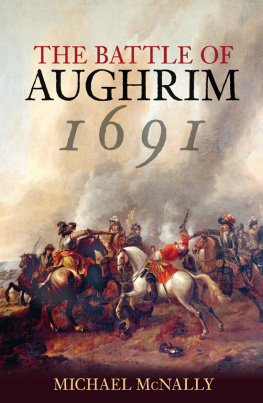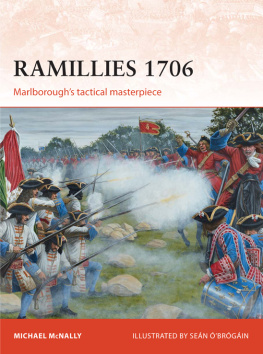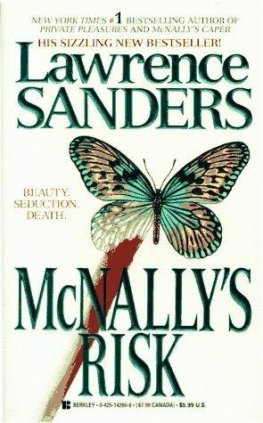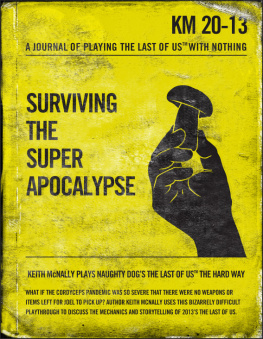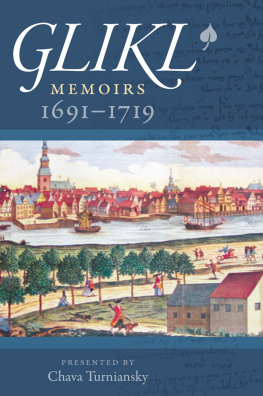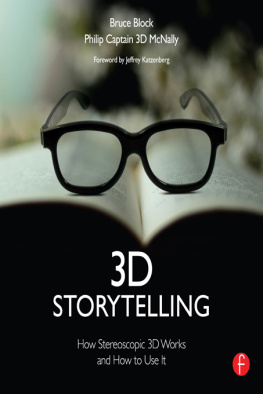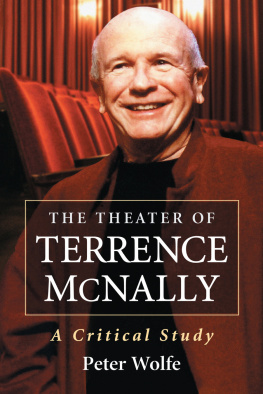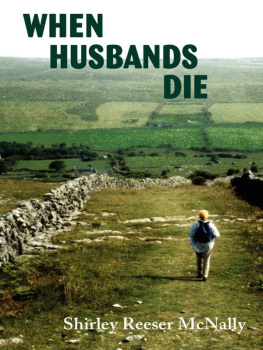Michael McNally - The Battle of Aughrim 1691
Here you can read online Michael McNally - The Battle of Aughrim 1691 full text of the book (entire story) in english for free. Download pdf and epub, get meaning, cover and reviews about this ebook. year: 2008, publisher: The History Press, genre: Art. Description of the work, (preface) as well as reviews are available. Best literature library LitArk.com created for fans of good reading and offers a wide selection of genres:
Romance novel
Science fiction
Adventure
Detective
Science
History
Home and family
Prose
Art
Politics
Computer
Non-fiction
Religion
Business
Children
Humor
Choose a favorite category and find really read worthwhile books. Enjoy immersion in the world of imagination, feel the emotions of the characters or learn something new for yourself, make an fascinating discovery.
- Book:The Battle of Aughrim 1691
- Author:
- Publisher:The History Press
- Genre:
- Year:2008
- Rating:3 / 5
- Favourites:Add to favourites
- Your mark:
- 60
- 1
- 2
- 3
- 4
- 5
The Battle of Aughrim 1691: summary, description and annotation
We offer to read an annotation, description, summary or preface (depends on what the author of the book "The Battle of Aughrim 1691" wrote himself). If you haven't found the necessary information about the book — write in the comments, we will try to find it.
The Battle of Aughrim 1691 — read online for free the complete book (whole text) full work
Below is the text of the book, divided by pages. System saving the place of the last page read, allows you to conveniently read the book "The Battle of Aughrim 1691" online for free, without having to search again every time where you left off. Put a bookmark, and you can go to the page where you finished reading at any time.
Font size:
Interval:
Bookmark:
The Battle of
AUGHRIM
1691
About the Author
Michael McNally is a military historian whose other books include The Battle of the Boyne 1690 and Easter Rising 1916: Birth of the Irish Republic. He is currently completing a study of Cromwells campaign in Ireland. He lives with his wife and family near Cologne in Germany.
The Battle of
AUGHRIM
1691
MICHAEL McNALLY

Dedication
Id like to dedicate this book to my father, Brendan McNally,
who tragically passed away as the manuscript was being completed
This ones for you, Dad.
Front cover: A Cavalry Skirmish by Jan Wyck c. 16401702.
Ulster Museum 2008. Collection: Ulster Museum, Belfast.
Photograph reproduced courtesy of the Trustees of National Museums Northern Ireland.
First published 2008
The History Press
The Mill, Brimscombe Port
Stroud, Gloucestershire, GL5 2QG
www.thehistorypress.co.uk
This ebook edition first published in 2013
All rights reserved
Michael McNally, 2008, 2013
The right of Michael McNally to be identified as the Author of this work has been asserted in accordance with the Copyrights, Designs and Patents Act 1988.
This ebook is copyright material and must not be copied, reproduced, transferred, distributed, leased, licensed or publicly performed or used in any way except as specifically permitted in writing by the publishers, as allowed under the terms and conditions under which it was purchased or as strictly permitted by applicable copyright law. Any unauthorised distribution or use of this text may be a direct infringement of the authors and publishers rights, and those responsible may be liable in law accordingly.
EPUB ISBN 978 0 7524 9658 0
Original typesetting by The History Press
Contents
Acknowledgements
Firstly Id like to thank my wife, Petra, and children Stephen, Elena and Liam for their extreme patience and for putting up with me during the preparation of this book. Id also like to thank the following people who have freely given their time to assist with proof reading the original manuscript or offering insights into or comments regarding various incidents and individuals mentioned therein any mistakes remaining are my own Andy Copestake, Ian Spence, Lee Offen, Dr David Murphy, Rt Hon Bryan Bellew, Danny Walsh and Martin Francis.
Id also like to thank my editor at The History Press, Jonathan Reeve, for his help and encouragement, and the staffs of the various museums and institutions who have kindly given permission for the use of a number of images reproduced within this book.
Finally, I would like to offer my special thanks to Thomas Brogan and his wife, Mary, for travelling halfway across Ireland when injury meant that I was unable to travel purely to take the battlefield photography and for producing the excellent maps which accompany the text; Robert Hall for the production of the two plates depicting uniforms from the combatant armies and last, but by no means least, a heartfelt thank you to Sen OBrogan for skilfully converting my interpretation of certain events into the various plates which bring the battle so vividly to life.
A Note on Spelling
For the Jacobite Irish and their French allies, language was often a seemingly insurmountable barrier, with many names being mangled in translation. In the case of Charles de Chalmont, there are no less than eleven different versions of his title, for ease I have therefore followed common practice and referred to him as the Marquis de St Ruth.
Similarly, and to be strictly accurate, St Ruths opponent should simply be referred to as Godard van Reede, Heer van Reede, as he did not inherit the titles by which he is commonly known until the death of his father Godard Adriaan van Reede, Heer van Amerongen and Heer van Ginkel in October 1691. However, and again to ease possible confusion, I have followed convention and referred to him as van Ginkel.
Campaign Map

Introduction
The crucial point of King James IIs reign came neither on the battlefield nor in the diplomatic arena, but at St Jamess Palace in London when, on 7 December 1687, it was announced that after fourteen years of marriage, during which four children had died in infancy, his wife, Queen Mary Beatrice, was once again expecting a child.
The accession of James, Duke of York, in February 1685, and his subsequent coronation as King James II of England, Ireland and France and VII of Scotland had been treated with relative indifference by the majority of his new subjects: Although a Roman Catholic, he was by virtue of his position as King, the head of the Anglican Church and this aberration in the religious status quo was tolerated in the certainty that he would be succeeded on the throne by either of his adult and staunchly Protestant daughters, the Princesses Mary and Anne, both of whom were married to suitably Protestant princes Mary to William Henry van Nassau, Prince of Orange and Stadtholder of the United Dutch Provinces and Anne to Prince George, the younger brother of King Christian V of Denmark.
The first months of his Personal Rule were not without danger for the new king, as he had to survive a two-pronged attack from rebel forces under the command of James Scott, Duke of Monmouth and Buccleuch an illegitimate son of Charles II who had languished in Rotterdam since 1683 and Archibald Campbell, the 9th Earl of Argyll, a central figure within the community of Anglo-Scots exiles in Amsterdam.
The twin invasions were badly co-ordinated with Argyll meeting little enthusiasm even from his own clansmen and after his army collapsed he was captured at Inchinnan on 18 June, being executed in Edinburgh twelve days later.
Monmouth however landed at Lyme Regis in Dorset on 11 June, at a time when the Scots rising had almost run its course, proceeding to Taunton where he had himself proclaimed as the True King James, stating that he had been legitimised by his late father, and that his uncles accession was therefore illegal.
A popular figure, thousands flocked to Monmouths standard, but no longer having to worry about the situation in Scotland, Government troops under the command of Louis de Duras, the French-born Earl of Feversham, marched into the West Country to meet the invader. The two forces met at Sedgemoor during the early hours of 6 July 1685 and after three hours confused fighting, Monmouths superior numbers proved to yield little advantage against the Royal Army.
In the ensuing rout the Duke was captured and taken to London where he was executed on Tower Hill on 15 July. Mistaking the ground-swell of public opinion, James then made a serious miscalculation by instructing his Lord Chief Justice Sir George Jeffreys to conduct a series of flying courts in the areas through which Monmouth had campaigned. Known as the Bloody Assizes over 1,400 cases were tried, with many of the defendants being found guilty on the flimsiest of excuses. In all some 300 of the defendants were executed with a further 600 being transported to the Caribbean for use as slave labour, few if any of the remainder were acquitted, instead being committed to prison which, in itself, was tantamount to a death sentence.
Deliberately distant from the people, James continued, as his reign progressed, to initiate policies which took no account of public opinion. In 1686 he began measures to increase the standing army to over 20,000 men, and the following year attempted to introduce the Declaration of Indulgence, a device which he believed to be a sincere attempt to reduce the gulf between the established Church of England, i.e. Anglicanism, and other Christian doctrines. To many, the intent behind the document was bound up in a single clause which voided the Test Acts, in effect opening up the government and the military to Roman Catholics, which many believed to be a precursor to the establishment of an absolutist state similar to the France of King Louis XIV.
Next pageFont size:
Interval:
Bookmark:
Similar books «The Battle of Aughrim 1691»
Look at similar books to The Battle of Aughrim 1691. We have selected literature similar in name and meaning in the hope of providing readers with more options to find new, interesting, not yet read works.
Discussion, reviews of the book The Battle of Aughrim 1691 and just readers' own opinions. Leave your comments, write what you think about the work, its meaning or the main characters. Specify what exactly you liked and what you didn't like, and why you think so.

